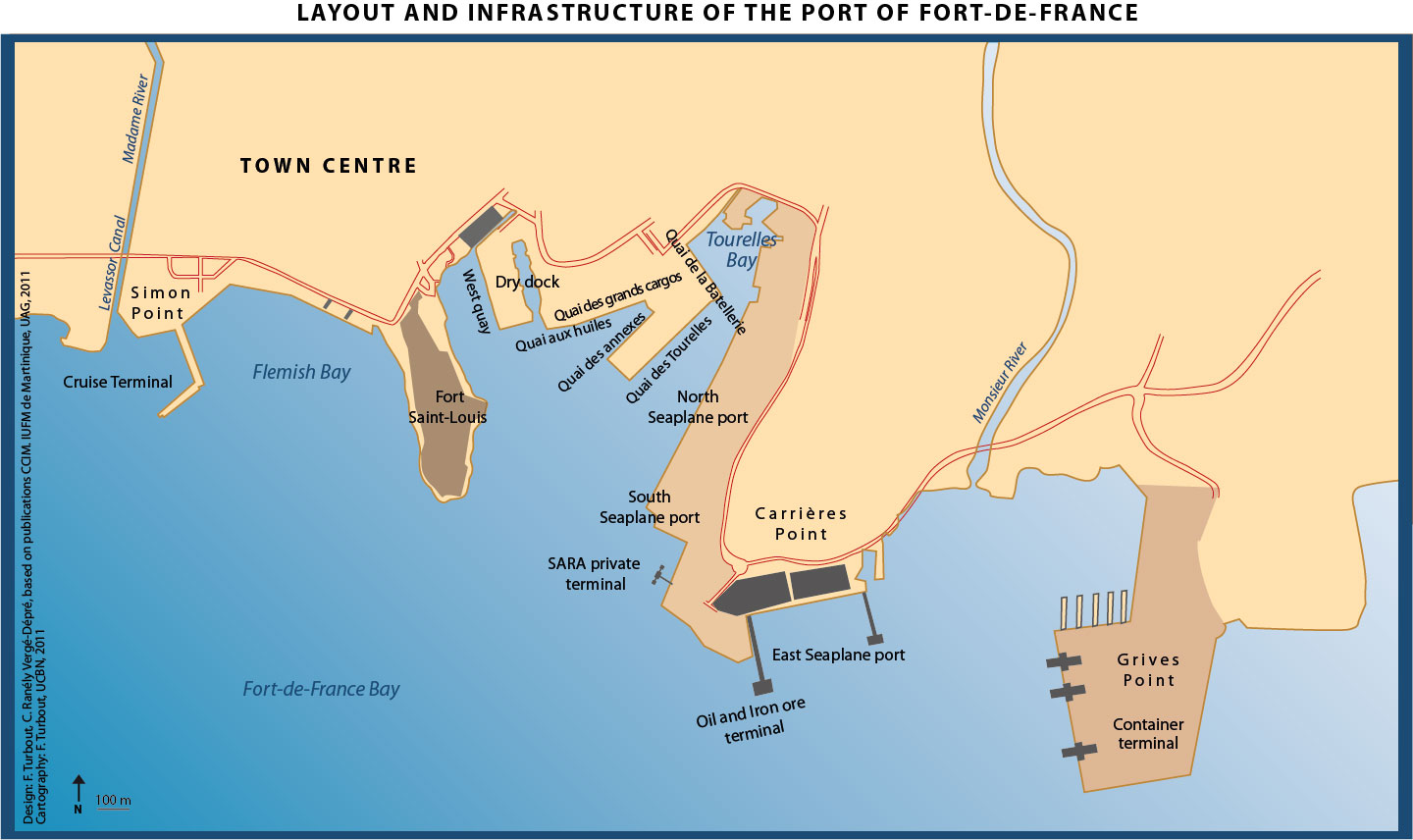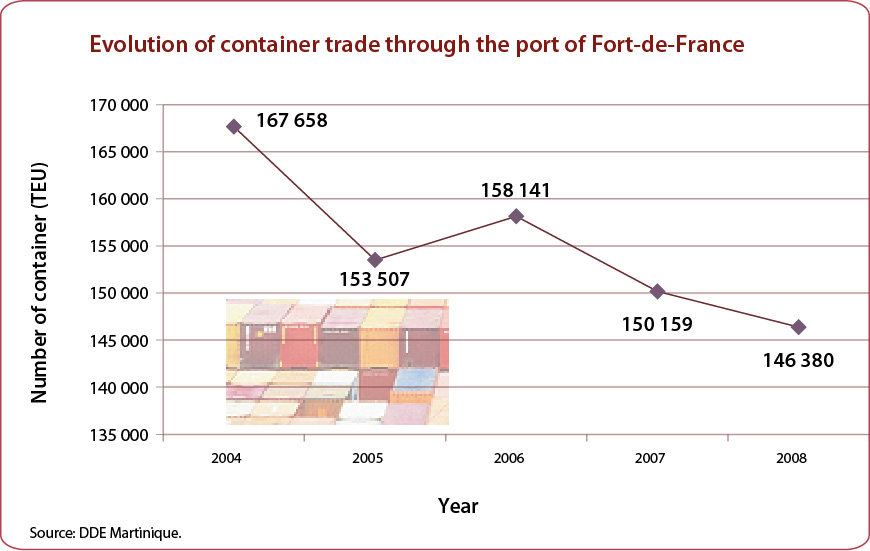
- "Boucle Centre-Artibonite" d'Haïti FR ES
- Antigua-et-Barbuda FR
- Bahamas FR
- Barbados
- Haïti FR
- Haïti : De ruptures en ruptures, un territoire en mutation FR ES
- Haïti : La persistance d'un état de crise et de la crise de l'Etat FR ES
- Haïti : Situation de l'agriculture 2024 FR
- Haïti : les empreintes majeures d'une identité plurielle FR ES
- Jamaïque FR
- La Guyane : un des derniers Far West FR
- La Martinique : un mal développement îlien FR ES
- Martinique
- Port of Fort-de-France (Martinique)
- Port of Pointe-à-Pitre/Jarry (Guadeloupe)
- Puerto Rico
- République dominicaine FR ES
- St. Vincent and the Grenadines
- Trinidad and Tobago (2000-2005)
- Venezuela FR
As Martinique's principal port complex, the port of Fort-de-France handles the quasi-totality of the island's external trade. Adjoining the capital city, it constitutes a strategic economic and social pole, situated only some eight kilometres from the international airport. Despite constant re-organisation and modernisation of its infrastructure, the port had had to confront highly competitive stakes due largely to an increasingly fierce, more globalised international context. This explains the current review of its management structure and policies, aimed at re-launching its declining passenger and cargo traffic.
Port infrastructures
Located at the edge of the very dense urban fabric of the Fort-de-France district, the port area essentially covers the upper reaches of a natural harbour, sheltered to the West by the promontory of Fort Saint-Louis, recalling its military past, and to the East by Carrières Point. The full occupation of this initial site led to an extension of the port further to the East with the construction of a new terminal at Grives Point to which container handling activities have been transferred since October 2003. The port covers some 2.7 kilometres of quays with a land area of more than 30 hectares.
Since the 1990s, the organisation and development of the port infrastructure has focussed around several major axes, as part of a general reorganisation of the overall space in question:
- The centrally located quays are being given over more and more to the cruise industry; the Tourelles quay (the former liner terminal) has space for two moorings, but with the inconvenience of being eccentrically situated relative to the town centre. For this reason, a new cruise terminal was constructed in 1992 at Simon Point, along the sea frontage of the town centre. The redevelopment of the urban fringe around the 'old port,' stretching from Savane Park to Tourelles Bay acts as a better gateway from the port into the town, given that for a long period the latter paradoxically appeared to turn its back on its own port. At West Quay, a new maritime rail terminal for inter-island passenger traffic was opened in 2010, giving pedestrian access to the town centre. Also found in this same sector of the port is a dry dock dating back to the Second Empire, and enlarged in 1951 to accommodate both the maintenance and repair of ships up to a dead weight of 20 000 tonnes.
- The firs specialised quays were constructed to the East, from the 1960s onwards: the old banana quay, the so-called 'hydrobase' (seaplane port), the oil and iron ore terminal for supplying clinker and crude oil, and the private SARA terminal (Antillean Public Limited Company Refining Association). The onset of containerisation of shipped sea cargo necessitated the construction of a first container terminal, located between the existing installations in the southern prolongation of the 'hydrobase' quay. 20 years later, with the congestion of this facility, the port of Fort-de-France would construct a new container terminal at Grives Point. The availability of large areas of open land, the willingness to support different urban projects such as the Abricot Pool Marina, or the development of the industrial port zone of Grives Point, provided additional factors behind the original choice of this site. The terminal presently covers 16 hectares, equipped with 3 container gantries, a main (double) quay of 460 metres, as well as another quay of 150 metres in length.
The old container terminal is now used for general cargo (loose/bulk goods and cartage).
Towards port reform?
The port of Fort-de-France is a designated national port, administered by the Chamber of Commerce and Industry of Martinique (CCIM), with its public authority status established in 1953 for a period of 50 years, extended to December 2010. Through powers delegated by the Prefect, the Departmental Office for Public Works oversees the stewardship of this concession. A reform of this statute is currently envisaged, given that the port infrastructures of Martinique, as well as those of Guadeloupe, French Guiana; and La Réunion, are implicated in the future reform of overseas ports. The latter decision follows on from the enactment of the port reform bill in metropolitan France of 4th July 2005, with 'autonomous' ports being replaced by the major maritime ports (GPM or 'Grand Port Maritime'), with two components:
- The one relating to governance: up to 1st January 2012, the present management would be replaced by e supervisory council (with membership chosen notably from local councils, port personnel, economic specialists, and other qualified representatives from the State), whose mission would be to establish strategic goals for the port, as well as a directorate charged with their execution;
- The other,to be involved in the transfer of public sector plant and equipment to the private sector.
An inter-ministerial committee established in 2009 deemed this reform necessary in order to increase the performance of these French overseas ports? However the latter has proved to be a matter of concern to the port authorities in question because of the important political and social stakes involved.
Port traffic
The port of Fort-de-France handles more than 3.1 million tonnes of cargo per annum, of which 70% is imported. This imbalance underlines the extroversion of the Martinique economy, subject to an ocean bound dependence for its supplies.
The imported goods (2 336 400 tonnes in 2008) comprise mainly crude oil imports destined for the SARA refinery (which supplies Guadeloupe and Martinique in refined petroleum products) and diverse containerised goods.
The refined oil products represent one half of exports, shipped in coastal vessels to Guadeloupe and the EDF power station of Bellefontaine, situated in the north-east of the island. The other half exported is made up of containerised traffic, amongst which are bananas whose total export (around 280 000 tonnes per year) is governed by vagaries of climate and problems of distribution.
Containerised traffic totalled 146 380 TEU in 2008, but the trend is downward since the middle of that decade.
Fort-de-France is nevertheless ranked 6th amongst French ports for this category. In the Lesser Antilles, it is comparable to Pointe-à-Pitre, but both fall below that of Port of Spain (Trinidad and Tobago). For a number of years, the French Antillean ports have nurtured the ambition of developing new roles in transhipment and redistribution of goods, gaining a share in the growth of intra-regional trade just when the main “hubs” of the Caribbean (Kingston, etc.) are becoming increasingly congested, and with the Panama Canal being widened. But in spite of the quality of equipment and infrastructure, such projects have face difficulties in taking off, as much at the level of port operation as in the performance of the logistical supply chain. The geography of the port traffic of Fort-de-France remains firmly concentrated on metropolitan France, Guadeloupe, and the rest of the Caribbean basin, as well as the different countries supplying the SARA refinery in petroleum products.
Amongst the development priorities of the port of Fort-de-France is the re-launching of the cruise industry, in constant decline since the last decade. After having achieved a total of 447 000 cruise ship visitors in 1995, the infrastructures in place saw only some 69 700 tourists in 2009. This decline is all the more significant given that the Caribbean still constitutes the foremost cruising destination in the world. The absence of any added attractions in the tourist product offered by comparison with that found in the cheaper, neighbouring Anglophone islands, coupled with an image tarnished by recurrent social conflict, explains the weaker competition offered by Martinique and Guadeloupe in this aggressively marketed sector, now largely dominated by major North American companies. The social upheavals of February 2009 saw the cancellation of some 20 port calls by cruise liners.
The port of Fort-de-France: recent trends in tourist cruise visits
| 2004 | 2005 | 2006 | 2007 | 2008 | |
| Nombre de passagers | 160 000 | 101 244 | 93 795 | 69 179 | 93 889 |
| Nombre d'escales de navires | 222 | 127 | 138 | 117 | 109 |
Trends in passenger ferry traffic with adjoining islands (Saint Lucia, Guadeloupe, Dominica) have also seen a decline, from 279 000 visitors in 2004 to 150 301 in 2008. Competition from faster air links, and the withdrawal of some ferry companies, largely explains this trend.
Selected references
France-Antilles Martinique, 19 mai 2010, « La réforme portuaire est lancée », p. 2.
Le Marin, 12 novembre 2010, dossier « Martinique, évolutions en vue », p. 17-26.
Jean-Etienne C., Les espaces portuaires et maritimes des Petites Antilles : les cas de Fort-de-France, Pointe-à-Pitre et Castries, Thèse de doctorat, Université des Antilles et de la Guyane, 2008, 277 p.
Ranély Vergé-Dépré C., Chardon J.P., « Le Bassin caraïbe : un carrefour maritime ? », Festival International de Géographie, Saint-Dié-des-Vosges, octobre 2009, http://fig-st-die.education.fr/actes/actes_2009/chardon/article.html
Ranély Vergé-Dépré C., « Le transport maritime de passagers aux Antilles françaises : évolution, bilan et enjeux », Etudes Caribéennes, n° 2, 2005, p.33-39.
Ranély Vergé-Dépré C., Les Antilles françaises en transition : de la relation privilégiée franco-française à l’ouverture internationale. Essai d’une géographie des transports, Villeneuve d’Ascq, Presses universitaires du Septentrion, 1999, 362 p. (Thèse de doctorat de l’université, Université de Bordeaux III, janvier 1999).
Ranély Vergé-Dépré C., « Quinze années de conteneurisation des trafics maritimes aux Antilles françaises : éléments d’un bilan », Les Cahiers d’Outre-Mer, n° 198, Bordeaux, 1997, p. 151-170.
http://www.martinique.port.fr
top
|
  |
















